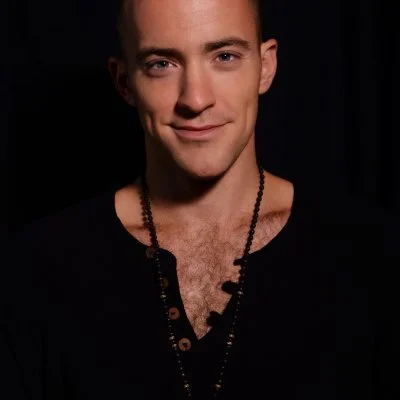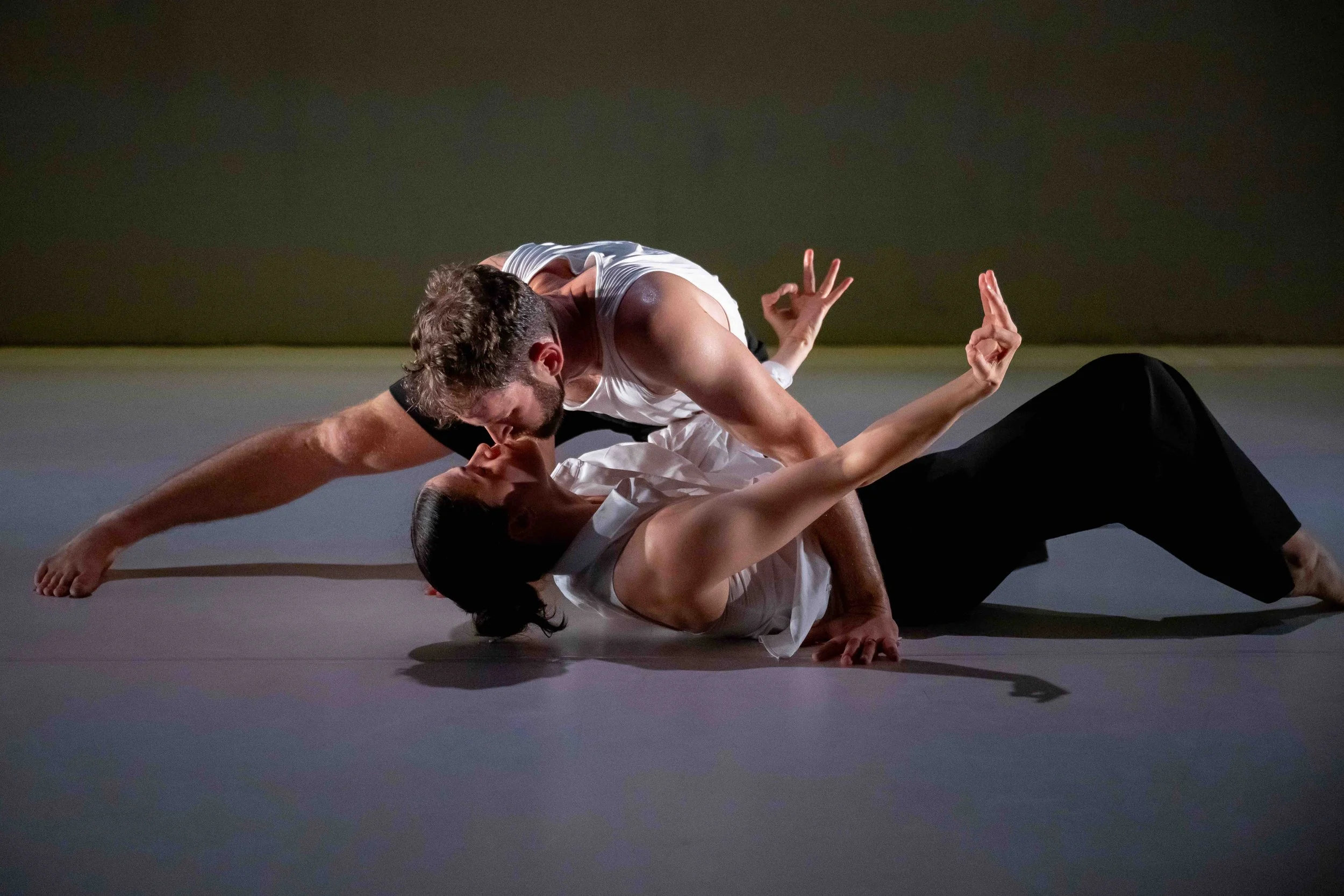Throe brings human frailty and struggle to Corporeal Imago’s atmospheric new aerial-dance hybrid
Cirque-trained, Vancouver-based Gabrielle Martin and Jeremiah Hughes strive to create something deeper than spectacle
Corporeal Imago’s Throe. Photo by Darryl Ahye
The Dance Centre presents Corporeal Imago’s Throe at the Scotiabank Dance Centre from November 17 to 19
AN AERIAL ARTIST haltingly grasps and climbs a rope upward in the dark, a partner on the ground holding it taut. Later, in the new work Throe, a performer dangles upside-down, the rope wrapped around their waist, holding a limp figure from falling into the mist below.
Instead of mighty, superhero circus acrobats performing dazzling feats, they’re more like frail humans struggling to survive. And that’s exactly the point. In many ways, Gabrielle Martin and Jeremiah Hughes—partners in the Vancouver-based performance company Corporeal Imago—say their dancers are doing the opposite of what a performer might aim for in Cirque du Soleil.
“A lot of Cirque is the kind of experience where you want to see bodies doing things onstage that you don’t relate to; a lot of it is ‘I could never do that!’” says Martin, speaking over the phone with Hughes as they walk their baby along the waterfront. “We were more interested in what an audience could relate to—reflecting their experiences.”
“In Cirque, it’s almost deified,” adds Hughes. “The bodies are doing incredible things and the acrobats will even stop for an applause break. It’s a formula—and it works!
“But, honestly, it’s easier to make things look easy,” he adds. “You just put on a plastic face and make it look easy.”
They know firsthand what they’re talking about. The couple met as performers with Cirque du Soleil. From 2011 to 2015, Martin had toured full-time with Cavalia, performing aerial rope, bungee trapeze, bungee dance, and harness dance numbers, before joining Cirque’s TORUK - The First Flight as a principal performer. (She counts about 1,400 international appearances over her time with both those shows.) Hughes, meanwhile, had performed for Cirque’s Viva ELVIS, joining TORUK to tour in its lead male role from 2015 to 2019. And now, with their own company, they want to take those techniques and do something completely different—productions on a human scale that’s far removed from the spectacle of the big tent or Vegas stage. And increasingly, that means reaching back into their own contemporary-dance backgrounds.
The pair started choreographing their own work together in 2018 while still working with Cirque—as Hughes describes it, on their tour breaks “when everybody else was resting their bodies”. By 2019 they had premiered their first work, choreographed for themselves: Limb(e)s hit Montreal before touring to Assembly Festival and the Edinburgh Festival Fringe. By 2021, now based in Vancouver, they launched its cinematic adaptation at the Dancing on the Edge Festival and elsewhere—tapping into a wider creative team here.
Whereas the pair had performed Limb(e)s themselves, for Throe, which will mark their company’s first live premiere in their hometown, they chose to cast contemporary dancers: Marissa Wong, Brenna Metzmeier, Isak Enquist, Jeremiah Hughes, Alex Tam, and Eowynn Enquist. That’s partially due to the fact that there were more highly trained dancers than aerialists here in Vancouver (versus Montreal); but the rationale also circles back to what the pair realized as they reflected on their work. “We said, honestly, our core is dance, and it’s not so much about the virtuosity—we’d rather do less and say more,” explains Hughes.
Training dancers to do ropes took months of training, of course. “We would do technique classes and circus classes as well as physical conditioning—sometimes it was just running on the Seawall and doing some pullups,” Hughes says. “They’re inspired and we’re feeling very impressed and humbled.”
“There’s something really addictive about aerial training—that’s been my truth,” comments Martin. “It’s very inspiring but also to do it yourself is so empowering.”
In Throe, they leverage the larger, human metaphor of figures struggling and working together to defy gravity on those ropes.
“It speaks to something about this desire to ascend—the myth of Icarus is in there, and we’re definitely leaning into that,” says Martin. “We talked about agency versus fate. We overcome our fears through sheer will. You can see the work: the literal struggle to stay up there and ascend.”
The pair has developed an entire, dystopian visual space around the dancers, who are washed in an eerie amber lighting.
“These bodies are sort of set in an inhospitable world,” Martin explains. “The bodies are small and vulnerable and fragile in this environment, and they need to work together.”
Jeremiah Hughes
Gabrielle Martin
“I was thinking of the moments right after a disaster, and the capacity to find hope in those environments,” Hughes says of the atmosphere and Sophie Tang’s lighting design, “to make it be like there was just a forest fire or a volcano went off or there was a nuclear meltdown.”
Jo Hirabayashi’s haunting original soundscape, inspired by cosmic noise, heightens the sense of vast, timeless struggles.
Freshly inspired, Hughes and Martin (who is on maternity leave from her other important role, as director of programming at the PuSh International Performing Arts Festival), are enjoying developing a new performance language here on the West Coast.
“It’s a nutrient rich soil—it has so many resources and professionals who are hungry for work,” Hughes observes.
“People are kind of interested in the aerial aspects of our work here,” Martin adds with a laugh. “Had we started it in Montreal, that might not have been quite so much of a novelty.”















